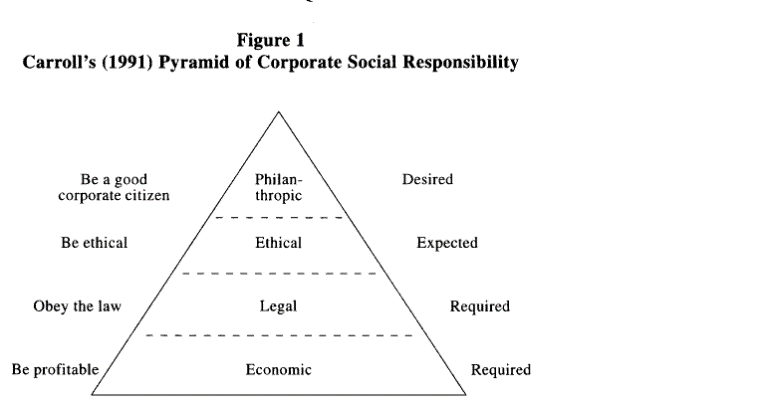A Brief History of Corporate Social Responsibility | Kimberlee Josephson
A Brief History of Corporate Social Responsibility Foundation for Economic Education


Corporate Social Responsibility and the Role of Business in Society
CSR (Corporate Social Responsibility) gained notoriety with Howard R. Bowen’s 1953 publication Social Responsibilities of the Businessman, and although times have since changed and CSR has taken on various forms, a constant question remains unchanged.
The Role of Business in Society
What is the role of business in society? Some claim that a greater focus on corporate social performance over corporate financial performance is now warranted, while others adhere to a more classical viewpoint, siding with Theodore Levitt’s assertion that business should simply aim to achieve material gain while operating in good faith. Levitt, a German-American economist and professor at the Harvard Business School, spoke of “The Dangers of Social Responsibility” in a 1958 Harvard Business Review article. He posited that profit maximization over the long term should be the primary goal of business as this would have a spillover effect improving the wellbeing of society.
The propensity to exchange to benefit oneself as a means for societal advancement was most notably espoused in Adam Smith’s 1776 magnum opus, The Wealth of Nations. Milton Friedman later drove this message home in his seminal essay in the New York Times Magazine about how the “The Social Responsibility of Business is to Increase its Profits.”
The Evolution of Corporate Social Responsibility
Yet, the prioritization of self-gain has proven to be a hard pill to swallow for a culture that seeks emotional fulfillment via altruism. As such, businesses have not only been encouraged to engage in CSR, but also to harness it and pursue a higher calling.
A prominent depiction of the evolution of business interest in CSR, along with society’s expectations for business behavior, is Archie Carroll’s CSR Pyramid, first published in 1991.

- Economic Responsibility: Firms should be a productive element of society and contribute to the financial wellbeing of the organization.
- Legal Responsibility: Firms should abide by the ground rules and regulations within the societies they operate.
- Ethical Responsibility: Firms should adhere to certain expectations to maintain a healthy relationship with society.
- Discretionary Responsibility: Firms should engage in philanthropy, giving back to society.
The CSR Pyramid is still widely referenced and Dr. Wayne Visser, CSR professional, attests it to be a useful framework for managerial decision making. However, over time, the expectations for the top two tiers of the pyramid have expanded, and even what constitutes ethical behavior has evolved since Carroll’s publication.
The Shift Towards Sustainable Development Goals
In today’s competitive landscape, CSR constitutes a management strategy that goes beyond corporate giving and charitable networks. In fact, as defined by the United Nations, CSR is quite distinct from philanthropy given that it takes into consideration the social and environmental impact of a firm in addition to an economic impact.
An emphasis on the people, planet, and profit has become par for the course, and a variety of methods and forms of assessment regarding sustainability have come about for companies to prove their “good” work. John Elkington, who coined the term triple bottom line (TBL) for determining the social, environmental, and economic impact of a firm, claims TBL doesn’t go far enough and the business view of CSR is too narrow. He claims that firms should go beyond aiming to be the “best in
SDGs, Targets, and Indicators
1. Which SDGs are addressed or connected to the issues highlighted in the article?
- SDG 8: Decent Work and Economic Growth
- SDG 12: Responsible Consumption and Production
- SDG 17: Partnerships for the Goals
The article discusses the role of business in society, corporate social responsibility (CSR), and the evolving expectations for businesses to consider their social and environmental impact in addition to their economic impact. These issues are closely connected to SDG 8, which focuses on promoting sustained, inclusive, and sustainable economic growth, full and productive employment, and decent work for all. It is also connected to SDG 12, which aims to ensure sustainable consumption and production patterns. Additionally, SDG 17, which emphasizes the importance of partnerships and collaboration, is relevant as it highlights the need for businesses to work together with other stakeholders to achieve sustainable development.
2. What specific targets under those SDGs can be identified based on the article’s content?
- SDG 8.4: Improve progressively, through 2030, global resource efficiency in consumption and production and endeavor to decouple economic growth from environmental degradation.
- SDG 12.6: Encourage companies, especially large and transnational companies, to adopt sustainable practices and to integrate sustainability information into their reporting cycle.
- SDG 17.17: Encourage and promote effective public, public-private, and civil society partnerships, building on the experience and resourcing strategies of partnerships.
Based on the article’s content, the following targets can be identified:
– SDG 8.4 is relevant as it highlights the need to improve resource efficiency in consumption and production, which aligns with the article’s discussion on responsible consumption and production.
– SDG 12.6 is relevant as it emphasizes the importance of companies adopting sustainable practices and integrating sustainability information into their reporting, which is discussed in the article in relation to CSR and the social and environmental impact of businesses.
– SDG 17.17 is relevant as it calls for effective partnerships between different stakeholders, including businesses, to achieve sustainable development goals. The article mentions the importance of businesses working together with other stakeholders to address societal issues.
3. Are there any indicators mentioned or implied in the article that can be used to measure progress towards the identified targets?
- Indicator 8.4.1: Material footprint, material footprint per capita, and material footprint per GDP
- Indicator 12.6.1: Number of companies publishing sustainability reports
- Indicator 17.17.1: Amount of United Nations Development Assistance Framework (UNDAF) resources mobilized for partnerships
The article does not explicitly mention specific indicators, but based on the identified targets, the following indicators can be used to measure progress:
– Indicator 8.4.1: This indicator measures the material footprint, which refers to the amount of resources used by an economy or society. It can be used to assess progress in improving resource efficiency in consumption and production.
– Indicator 12.6.1: This indicator measures the number of companies that publish sustainability reports, which reflects their adoption of sustainable practices and integration of sustainability information into their reporting cycle.
– Indicator 17.17.1: This indicator measures the amount of resources mobilized for partnerships through the United Nations Development Assistance Framework (UNDAF), which can be used to assess the level of collaboration and partnership between different stakeholders.
4. Table: SDGs, Targets, and Indicators
| SDGs | Targets | Indicators |
|---|---|---|
| SDG 8: Decent Work and Economic Growth | 8.4: Improve progressively, through 2030, global resource efficiency in consumption and production and endeavor to decouple economic growth from environmental degradation. | Indicator 8.4.1: Material footprint, material footprint per capita, and material footprint per GDP |
| SDG 12: Responsible Consumption and Production | 12.6: Encourage companies, especially large and transnational companies, to adopt sustainable practices and to integrate sustainability information into their reporting cycle. | Indicator 12.6.1: Number of companies publishing sustainability reports |
| SDG 17: Partnerships for the Goals | 17.17: Encourage and promote effective public, public-private, and civil society partnerships, building on the experience and resourcing strategies of partnerships. | Indicator 17.17.1: Amount of United Nations Development Assistance Framework (UNDAF) resources mobilized for partnerships |
Behold! This splendid article springs forth from the wellspring of knowledge, shaped by a wondrous proprietary AI technology that delved into a vast ocean of data, illuminating the path towards the Sustainable Development Goals. Remember that all rights are reserved by SDG Investors LLC, empowering us to champion progress together.
Source: fee.org

Join us, as fellow seekers of change, on a transformative journey at https://sdgtalks.ai/welcome, where you can become a member and actively contribute to shaping a brighter future.







